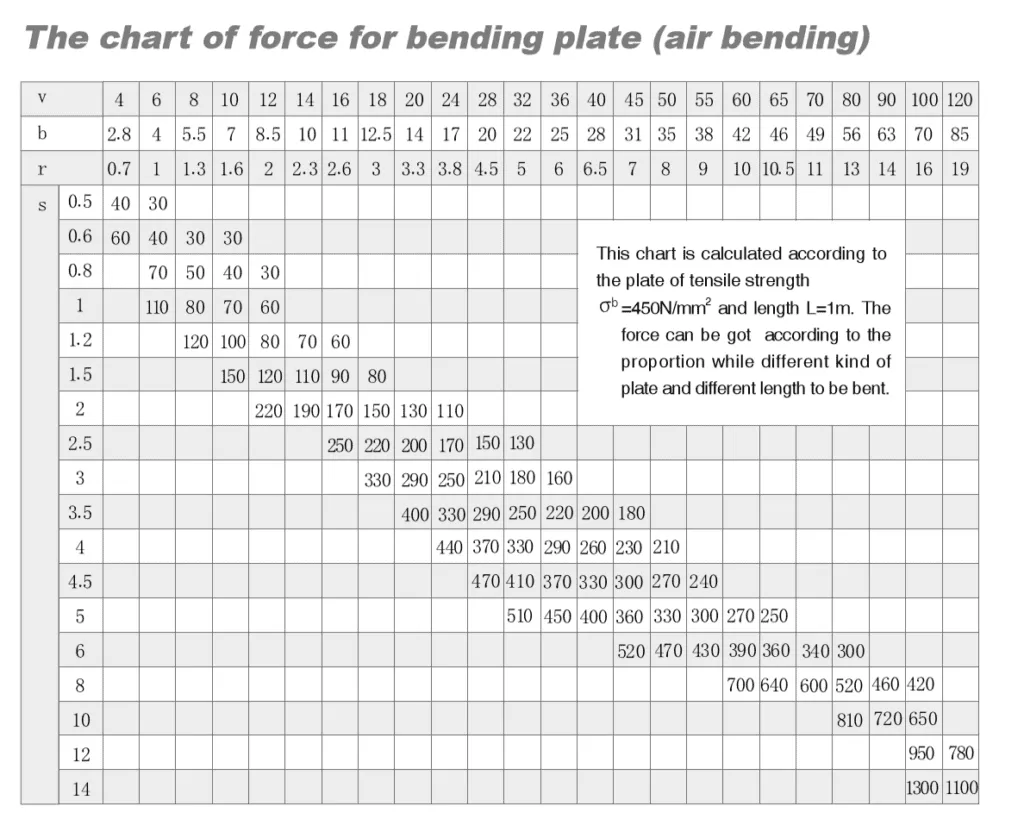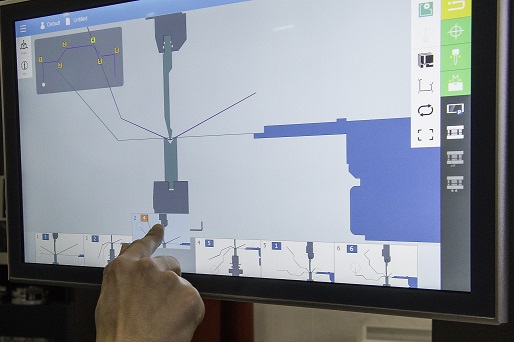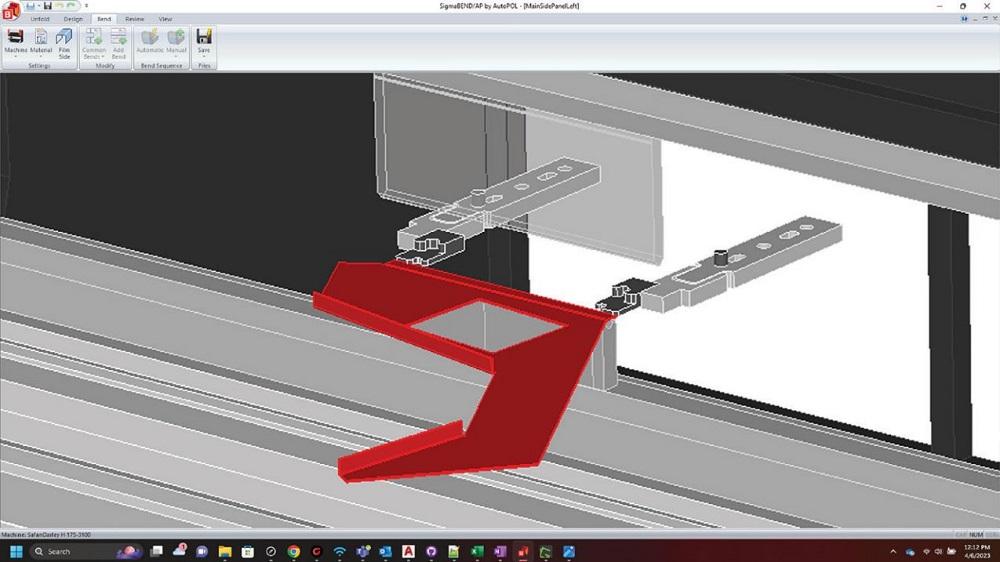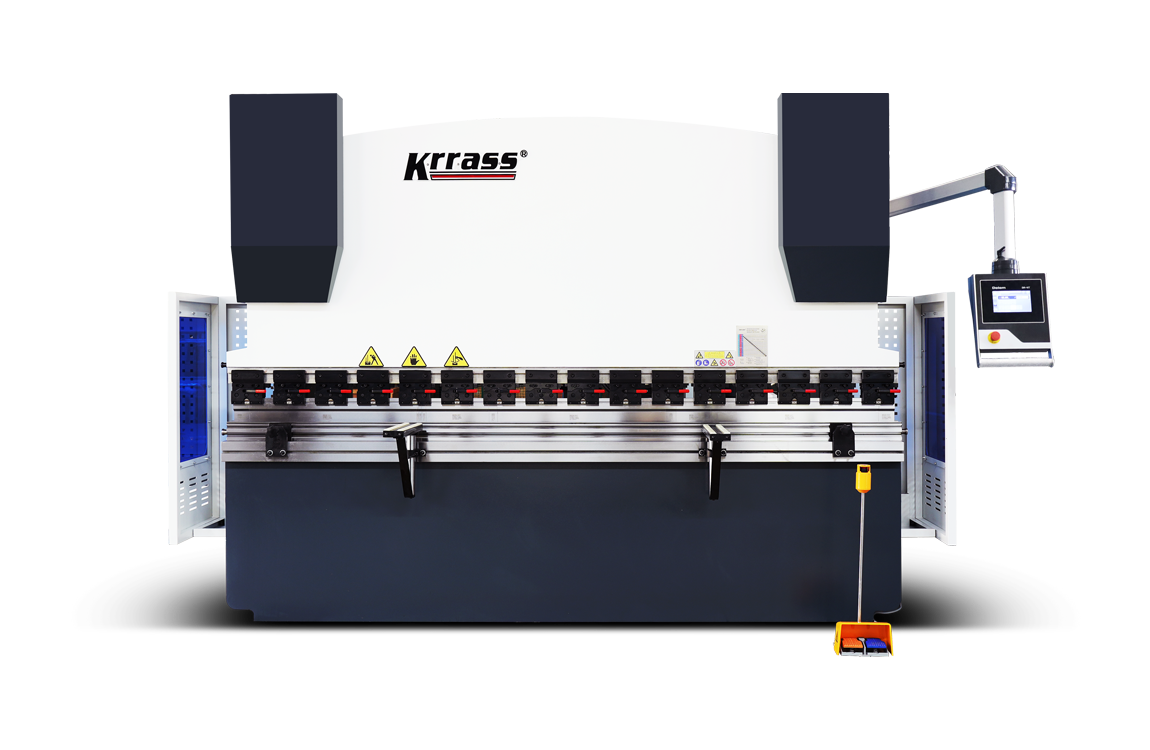When you begin exploring press brake machine price, you may find a variety of press brake machines on the market, differing in brands, models, and costs. In the manufacturing industry, press brake machines are crucial equipment used to bend metal sheets into various shapes to meet the needs of different engineering projects. However, in addition to focusing on performance and features, finding the right press brake machine also involves considering its price. In this article, we will delve into the pricing factors of press brake machines and discuss how to achieve the best value for money when making your selection.
What Is A Press Brake Machine
A press brake is a piece of manufacturing equipment that is used to bend sheet metal. It is typically narrow and long so that large pieces of sheet metal can be bent by it. Press brakes perform these bends by clamping the sheet or plate between the movable punch and the stationary die. The bends are all predetermined, and the punch and die are designed for specific lengths and shapes. A metal may be bent several times by a press brake until the desired form has been achieved.
Bending Principle
Press brakes can make a variety of different bends on many different types of metals. When preparing to bend, it is important to consider the metal type being bent, the die, the punch, and the bending force.
Understanding the metal type is important because each metal has differing physical properties. For instance, a high carbon steel will generally be less bendable by a press brake than many aluminum alloys because of the differences in ductility and strength. Metals typically have a recommended minimum bend radius or distance that they can be bent to without being damaged.
The die and the punch used on the press brake both have a large impact on the bending results. They are a set designed in such a way that when the sheet metal is clamped between them it bends into the pre-determined shapes and angles. The die is a hollow material that the metal is placed on top of prior to bending. It is a very hard and strong substance that is near in form to the desired shape of the metal being bent.
The punch is a solid material that is lowered down onto the metal. Since the pressing action of the punch onto the metal and the die are what causes the metal to bend, both shapes must be accurately suited to the bending job.
The correct metal shape following a press brake operation is dependent on the size and shape of the punches and dies. Dies and punches are typically designed in such a way that they can be interchanged easily to accommodate a wide array of jobs.
3 Basic Understandings About Press Brakes
- Press brakes come in a variety of sizes and capacities. Small hand-operated units capable of bending small pieces of sheet metal and large, computer-controlled units capable of bending large pieces of plate steel. The size and capacity of a press brake is determined by the length of the bed and the tonnage. The length of the bed (the area where the metal is placed during bending), and the tonnage (the amount of force the press brake can exert).
- Press brakes can be classified into two main types: mechanical and hydraulic. Mechanical press brakes use a mechanical force, typically provided by a flywheel and gears, to bend the metal. On the other hand, hydraulic press brakes use a hydraulic cylinder to provide the necessary force. Hydraulic press brakes are more versatile and efficient than mechanical press brakes and are, therefore, more commonly used in modern manufacturing operations.
- Press brakes can also be classified by their control systems. Some press brakes are operated manually, with the operator adjusting the position of the die and punch manually to achieve the desired bend. Other press brakes are operated with the aid of a computer numerical control (CNC) system, which allows the operator to input the desired bend angle. The press brake automatically adjusts the position of the die and punch to achieve the desired bend. CNC press brakes are more precise and efficient than manual press brakes and are often used in high-volume manufacturing operations. The control system is an important factor affecting the press brake machine price. Generally speaking, CNC controllers are more expensive than NC press brake controls. Please continue reading below for more information about control.
What Factors Affect Press Brake Machine Price
Size and Capacity
The size and bending capacity of the press brake machine can significantly affect its price. Larger machines with higher tonnage capacities for bending thicker and larger sheets typically come at a higher cost due to their increased materials and manufacturing requirements. Therefore, it is important to have an idea of the types of materials you are bending on the press brake; a material like stainless steel typically requires a press brake with more tonnage than mild steel or aluminum.
How To Determin Required Tonnage
Usually When people calculate the press brake tonnage, they can follow below press brake tonnage chart.
The value in the chart is the bending pressure when the length of the sheet is one meter:
Example: S=4mm L=1000mm V=32mm Check the table P=330kN.
This table is calculated based on the material with the strength σb=450N/mm2.
When bending other materials, the bending pressure is the product of the data in the table and the following coefficient:
Bronze (soft): 0.5;
Stainless steel: 1.5;
Aluminum (soft): 0.5 ;
Chrome molybdenum steel: 2.
Approximate calculation formula for bending pressure: P=650s2L/1000v, the unit of each parameter:
P——kN
S——mm
L——mm
V——mm

Control Systems and Automation
The type and sophistication of the control systems significantly impact the press brake machine price. Machines equipped with advanced numerical control (CNC) systems, intuitive software interfaces, and automation features tend to be more expensive. While these features enhance precision and efficiency, they also contribute to a higher upfront cost.
Value of CNC System
The application advantages of CNC system in bending machine are mainly reflected in two aspects:
1. Easier Setup
In the past, the setup process required a great deal of experience and was often performed by a dedicated supervisor. However, with the advent of offline programming, it is now possible to program the machine without the operator having to be trained to program the part. This frees up machine control to focus on production, which results in increased efficiency and a higher output of parts produced each day. By using a hydraulic clamping system to quickly change dies, changeover times are very fast because the dies are released and secured to the press brake, cylinder, and table clamping system at the touch of a button. With a manual clamping system, changeover times are longer because each individual punch and die must be released and then manually re-secured by the operator.

2. More Intelligent
CNC technologies impact not only the quality of the finished parts but also the level of experience required of the operator. For example, 3-D graphical simulations of the bending sequence prior to bending allow the operator to visualize the entire process, while CNC back gauge axes are displayed graphically to indicate the specific part of the back gauge that is being used for part positioning. If required, bend re-sequencing is easily achieved by dragging and dropping a bend step on the control. The bar code scanning of the laser-engraved part ID has enabled error-proof loading of the correct part program, while graphical and LED tool mapping displays clearly show the operator where each tool needs to be loaded and which type of tooling is to be used.

Common-used NC/CNC Controller Brands
Delem:
Delem is a well-established and respected brand in the world of press brake controllers. Known for their advanced CNC controllers, Delem offers a range of features that cater to the needs of the metalworking industry. Their controllers are recognized for their precision and reliability, making them a preferred choice for many metal fabrication professionals. Delem controllers often feature user-friendly interfaces and compatibility with various press brake models, allowing for seamless integration into existing workflows.
Controller Comparision
| DA-52S | DA-53T | DA-58T | DA-66T | DA-69T | |
| Screen parameters | 6.4 "Display Screen, Non-Touch | 10.1 "Multi-point Touch Screen | 15 "Multi-touch Screen | 17 "Infrared Touch Screen | 17 "Infrared Touch Screen |
| Programming mode | Manual programming | Manual programming | Manual Programming and 2D Graphic Programming | 2D Graphic Programming and 3D Graphic Display | 3D Graphics Programming and 3D Graphics Display |
| Fast clamping function of mould | Nonsupport | Nonsupport | Nonsupport | Support | Support |
| Networking settings | No | No | Optional | Complete Windows Application Package | Complete Windows Application Package |
| Number of control axes | Up to 4+1 Axis Control | Up to 4+1 Axis Control | Up to 4+1 Axis Control | Controllable 8+1 axis and above | Controllable 8+1 axis and above |
| Angle detection | No | No | No | Sensor interface with angle detection | Sensor interface with angle detection |
| Compatibility | No | No | No | DELEM-compatible modular structure | DELEM-compatible modular structure |
| Panel personalization | Panel cannot be personalized | Panel cannot be personalized | Panel cannot be personalized | OEM panels can be personalized | OEM panels can be personalized |
| Offline software | Offline software is not supported | Support offline software, USB interface can use any U disk and specified code | Support offline software, USB interface can use any U disk and specified code | Support offline software, USB interface needs to use randomly configured designated U disk | Support offline software, USB interface needs to use randomly configured designated U disk |
| Price | Low price but general configuration | The price is lower but the function is slightly less. | Reasonable price and more functions | High cost performance | Higher price but powerful function |
| Main passwords | Level 0:741 Level 1:14753 Level 2:32157 Level 3:25789 | ||||
Cybelec:
Cybelec is a Swiss brand with a strong presence in the press brake controller market. Their controllers are widely recognized for their precision and adaptability. Cybelec offers solutions for both standard and complex bending applications. Their controllers often feature user-friendly interfaces and powerful programming capabilities, making them an excellent choice for a variety of metalworking needs.
ESA:
ESA, or European Systems Automation, is another reputable brand that manufactures high-quality press brake controllers. ESA controllers are known for their innovation and flexibility. They offer a wide array of advanced features, including angle correction, collision avoidance, and network connectivity. These controllers are often chosen by manufacturers who require sophisticated capabilities and efficient production processes.
More information about press brake controller selection, pls read this article.
Brand & Manufacturer Reputation
The reputation and brand recognition of the press brake manufacturer play a crucial role in press brake pricing. Well-established and reputable brands may command higher prices due to the perceived reliability and quality of their machines. While there are reliable options from lesser-known manufacturers, brand reputation often influences buyer confidence and pricing. Here list the top 10 globle press brake machine maunfactures.
| Brand | Founded | Headquater |
| Amanda | 1946 | Kanagawa, Japan |
| Trumpf | 1923 | Ditzingen, Germany |
| LVD | 1952 | Gullegem, Belgium |
| Krrass | 1995 | Bowang, China |
| Accurpress | 1973 | Rapid City |
| Bystronic | 1964 | Niederönz, Switzerland |
| Salvagnini | 1963 | Italy |
| Cincinnati | 1898 | Harrison, Ohio |
| Durma | 1956 | Bursa, Turkey |
Customization and Options Influence Press Brake Machine Price
Usually, in addition to some standard configurations of the press brake, customers sometimes add some options according to their needs, or customize them, which will increase the cost of purchasing the press brake machine price. The following are the options that may be used.
- CNC Controls: Computer Numerical Control (CNC) systems allow for precise control over the bending process, including adjustments to angles, depths, and positions. CNC controls enable automation, repeatability, and the programming of complex bending sequences.
- Backgauge Systems: Backgauges help position the metal sheet accurately for bending, ensuring consistent results. Options may include manual, powered, or CNC-controlled backgauges with multiple axes for precise positioning.
- Tooling Systems: Press brake tooling, such as punches and dies, determines the shape and quality of the bends. Different tooling options are available for various bending applications, including air bending, coining, and hemming.
- Safety Features: Press brakes may come with safety features to protect operators and prevent accidents. These features can include light curtains, safety mats, interlocks, and emergency stop buttons.
- Hydraulic or Mechanical Drive: Press brakes can be powered by hydraulic or mechanical systems. Hydraulic press brakes offer smooth and precise control over the bending process, while mechanical press brakes may be more suitable for high-speed applications.
- Automatic Angle Correction: Some press brakes feature automatic angle correction capabilities to ensure accurate bending angles, even when bending materials with variations in thickness or properties.
- Angle Measurement Systems: Angle measurement systems help verify the accuracy of bends by providing real-time feedback on bend angles, allowing operators to make adjustments as needed.
- Offline Programming Software: Offline programming software allows operators to simulate and program bending sequences on a computer before executing them on the press brake machine. This can save time, reduce setup errors, and optimize production efficiency.
- Remote Monitoring and Diagnostic Tools: Some press brake manufacturers offer remote monitoring and diagnostic tools that allow operators to monitor machine performance, track maintenance schedules, and diagnose issues remotely, maximizing uptime and productivity.
- Customization Options: Manufacturers may offer customization options to tailor press brake machines to specific customer requirements, such as extended stroke lengths, special tooling configurations, or integration with other equipment.
Press Brake Machine Price Range
Hydraulic Press Brake Machine Price
Entry-Level Hydraulic Press Brakes: These can cost anywhere from $5,000 to $20,000. These are typically smaller machines with less complexity and tonnage.
Mid-Range Hydraulic Press Brakes: Machines in this category typically cost between $20,000 and $50,000. These machines often offer greater tonnage and length, as well as more advanced controls and features.
High-End Hydraulic Press Brakes: Top-of-the-line machines can easily cost $50,000 to $200,000 or even more, depending on the specific model and its features. These machines are typically used for heavy-duty applications and feature advanced control systems, high tonnage, and long bed lengths.
Small Press Brake Price
Small press brakes designed for light-duty work and smaller-scale projects typically range in price from around $10,000 to $30,000. However, the exact price can vary depending on factors such as brand, size, capacity, and features. Entry-level models or benchtop press brakes may be on the lower end of this price range, while more robust models with additional features such as CNC control and higher precision may fall toward the higher end. It's always a good idea to shop around and compare options from different manufacturers to find the best fit for your needs and budget.
Used Press Brake Machine Price
The price of a used press brake can vary widely depending on factors such as its age, condition, brand, size, capacity, and features. Generally, you can find used press brakes starting from a few thousand dollars for smaller, older models in fair condition, up to tens or even hundreds of thousands of dollars for larger, newer, or more advanced machines.
It's important to thoroughly inspect a used press brake before purchasing to ensure that it's in good working condition and meets your specific requirements. Factors such as the number of hours it has been used, the maintenance history, and any included accessories or tooling can also influence the price.
You can find used press brakes for sale through various channels, including online marketplaces, machinery dealers, auctions, and classified ads. Be sure to do your research and consider factors such as transportation costs, installation, and any potential refurbishment or repair expenses when evaluating the overall cost.
NC Press Brake Price
For smaller NC press brakes designed for light to medium-duty work, you can expect prices to start around $20,000 to $50,000. However, larger, more advanced NC press brakes with higher capacities and more features can cost anywhere from $50,000 to several hundred thousand dollars or more.
The exact price will depend on your specific requirements and the level of automation and precision you need. It's advisable to request quotes from multiple suppliers and compare specifications and prices to find the best option for your budget and needs.
CNC Press Brake Machine Price
CNC (Computer Numerical Control) press brakes offer advanced automation, precision, and flexibility compared to manual or NC-controlled machines, so they tend to be more expensive. The price of a CNC press brake can vary widely depending on factors such as brand, size, capacity, precision, additional features, and the level of automation.
For smaller CNC press brakes designed for light to medium-duty work, prices typically start around $50,000 to $100,000. However, larger, high-capacity CNC press brakes with advanced features can cost anywhere from $100,000 to several hundred thousand dollars or even more.
Is It Worth Buying A High-priced CNC Press Brake Machine
As technology advances, ancient tools are evolving into powerful and reliable assets tailored for the modern era, and CNC Press Brake Machines are a prime example. The superiority of modern CNC Press Brake Machines over traditional ones stems from various reasons, a few of which are highlighted below:
Enhanced Efficiency and Precision
Unlike their manual predecessors, traditional CNC Press Brake Machines operated with room for errors. However, CNC Press Brake Machines leave no margin for error. Fully automated, they eliminate the need for human intervention, ensuring smoother operations and a streamlined workflow, thus boosting efficiency and productivity.
Moreover, CNC systems deliver exceptionally precise results compared to older models, yielding faster outcomes, double the precision, and superior quality work. This advancement significantly enhances both efficiency and precision. Additionally, the operation and control of CNC Press Brake Machines are remarkably user-friendly.
Cost-Effectiveness
Traditional press brake machines incurred various expenses, contributing to higher overall costs. For instance, they often ran continuously throughout the day, regardless of actual usage, leading to unnecessary energy consumption. Moreover, the maintenance and upkeep of traditional press brake machines were considerably costlier.
In contrast, CNC Press Brake Machines offer a more economical solution. They require minimal maintenance, generate less waste, and are equipped with high-quality components and readily available parts in case of breakdowns. This cost-effective nature makes CNC Press Brake Machines a preferred choice for modern manufacturing operations.
Versatility and Wide Range of Use
One of the most significant advantages of press brakes is their versatility. They can be used to create a wide range of bends, angles, and shapes in sheet metal, from simple bends to complex geometries. This makes them an excellent choice for a variety of applications, from metalworking to manufacturing. And can be applied into diverse scenes.
Considerations For Buying A Press Brake
The first factor that most customers consider when purchasing a bending machine is price, but in addition to price, the following details should also be considered:
Tonnage
The first thing you need to consider when buying a press brake is the tonnage. Tonnage refers to the amount of force that the press brake can apply to the metal. The tonnage you need will depend on the thickness and type of metal you will be working with. For example, if you will be working with thin sheet metal, a press brake with a low tonnage may be sufficient. However, if you will be working with thicker plate metal, a press brake with a higher tonnage will be needed. It's important to note that the tonnage of the press brake will also affect the overall cost of the machine.
Bed Length
The second thing you need to consider when buying a press brake is the bed length. The bed length is the distance between the inside of the uprights of the press brake. The bed length will affect the maximum length of the metal you can bend. It's important to note that the longer the bed length, the more expensive the press brake will be. Therefore, it's important to choose a bed length that will meet your needs, but also falls within your budget.
Ram Stroke
The third thing you need to consider when buying a press brake is the ram stroke. The ram stroke is the distance that the ram (the part of the press brake that applies the force to the metal) can move. The ram stroke will affect the maximum depth of the bend that can be made. It's important to note that the longer the ram stroke, the more expensive the press brake will be. Therefore, it's important to choose a ram stroke that will meet your needs, but also falls within your budget.
CNC Control
The fourth thing you need to consider when buying a press brake is the CNC control. CNC (computer numerical control) is a type of control system that allows the press brake to be operated by a computer. CNC press brakes are more expensive than manual press brakes, but they offer several advantages. For example, CNC press brakes can be programmed to make multiple bends in a single operation, which can save time and increase productivity. They also have the ability to store multiple bend programs, which makes it easier to repeat a specific bend.
Safety Features
The fifth and final thing you need to consider when buying a press brake is the safety features. Safety is a crucial aspect when working with heavy machinery and press brakes are no exception. It's important to choose a press brake that has safety features such as emergency stop buttons, light curtains, and interlocks. These safety features will help to prevent accidents and injuries while working with the press brake.
Conclusion
Know the press brake machine price can make formed decisions when buying a press brake, some customers like Chinese brands, some customers like more expensive European and American brands, and some customers pursue cost-effectiveness.
KRRASS is a company specializing in the production of CNC machinery, with a product range that includes various metalworking equipment such as bending machines. KRRASS's CNC bending machines utilize advanced CNC technology to achieve precise bending of metal sheets, suitable for various sizes and thicknesses of metal materials. These machines are typically equipped with intuitive user interfaces and advanced control systems, allowing operators to easily program and monitor the production process.




